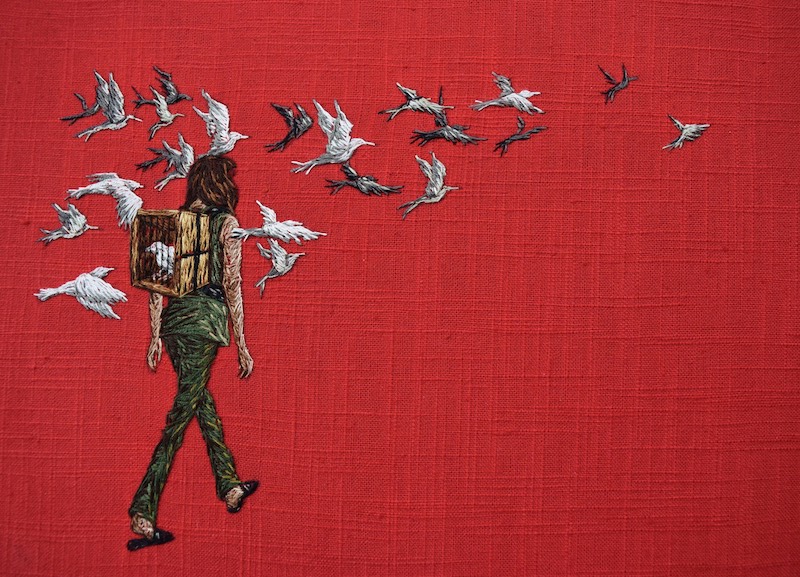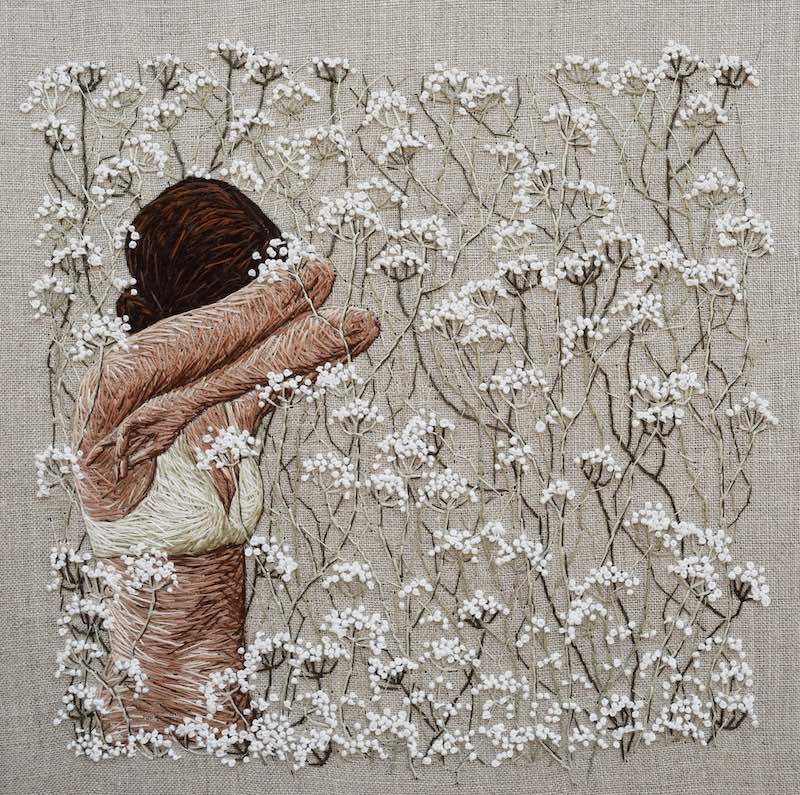With a strong sense of narrative, Michelle Kingdom embraces embroidery as an art form that has long been sidelined as “women’s work”. With lines of stitching, she creates textural drawings that explore stories of identity, relationships and perceptions.

Have you always been an artist? Did you have a “gateway craft” as a kid? Which creative projects led you to the work you do today?
Art has always been a big part of my life, though my path has taken a few detours along the way. I grew up in a creative house that included art, craft and textiles. I doodled as my daily routine with women who sewed surrounding me. My childhood wardrobe was mostly home sewn, with skills imparted through osmosis rather than proper instruction. Eventually I did head off for college to study fine art, armed with a natural ability and love for drawing, but also an interest in costume and fashion.
When and how did your interest in hand embroidery develop?
My initial interest in hand embroidery began while in art school where I studied drawing and painting. This was around 1990 and work that was oversized, highly conceptual, and impossibly clever dominated the art world. It mostly left me cold. I turned to embroidery on my own as an experiment, creating odd, tiny narratives with no expectations. Early pieces were mainly a safe refuge, off the judgmental radar of the “serious” art world.
As an Amazon Associate I earn from qualifying purchases. Read more about our affiliate linking policy.
Stitching privately and sporadically, I didn’t show my work to anyone for years because I didn’t think it would be of interest. So often textile work was overlooked as craft or women’s work, and needlework was particularly fraught with stigma. It was for grandmothers or colonial school girls, small in scale, fussy, domestic, nostalgic, feminine and deemed irrelevant. This was precisely why I adored it. I found it to be the perfect medium to tap into the mysterious world of the psyche.
The years passed by and life often got in the way of stitching. After the birth of my daughter, I returned to embroidery with a renewed sense of purpose. Now armed with decades of personal history and baggage, the medium seemed more relevant to me than ever. I slowly started to share my work on social media, happily surprised to find that others seemed interested, too. In 2014, I began to exhibit my work and have been showing ever since.

Your stitching style is your own. How would you describe it?
I describe my work as drawing with thread. I think, plan and execute as a draftsman. Most all of my work is filled and dense, but it is still composed of zillions of skinny lines.
What inspires your work? Does inspiration come from within you or is there an external impetus?
My inspiration and motivation to make work come primarily from within. I explore identity and relationships, and how our perceptions, particularly filtered through the lens of our inner lives, shape our reality. The continual tension of opposing dynamics, such as aspiration and limitation, expectation and loss, belonging and alienation, truth and illusion, fascinates me.
Each piece is a synthesis of several influences including memories, relationships, photographs, literature, personal mythology, art history and imagination. Ultimately my own personal experiences or those I have witnessed drive the concepts. Each piece is unique and stands on its own; however I view all of my embroideries as vignettes within a larger, more complete body of work.

When it comes to creating, are you more of a planner or an improviser?
Honestly I am both a planner and an improviser, and for me the most satisfying work comes from an interplay of the two forces. I tend to plan the concept and minimal sketch at the outset and let the work evolve along the rest of the way. I may have an idea of how it might go but I try to make decisions as the piece unfolds and not restrict myself by preconceived notions.

Your pieces are relatively small. Why do you work on a smaller scale?
When I first started stitching, the work was almost miniature at only a few inches. Slowly it has evolved, and is now anywhere from 10” to 25” which still is relatively small in the world of art. Part of what initially drew me to this medium was its minute intimacy that requires leaning in. It requires the viewer to slow down and take pause – or not participate at all.

The stitches themselves are the culmination of the creative process. Describe your process to prepare for the first stitch.
Each embroidery starts with the lengthy process of formulating and developing the concept. Sometimes I have a clear concept from the beginning but more often I have several vague images and ideas that I want to investigate. I lay out ideas almost like a collage and, after many sketches, refine a final drawing for a pattern. Then I transfer it to fabric to serve merely as a skeletal framework. I usually work on linen and even the choice of color and weight is an important foundation for the direction of the piece.

Once you have a design in mind, how do you decide where to take the first stitch? Do work from left to right? Foreground to background? Color by color? Or….?
Most all of my work is figurative and usually stitching begins with skin tones, then hair and faces. There is no set rule though, and I tackle each piece with individual steps. I don’t work directionally but rather by subject area. For example all the skin, hair and faces of people, then move to build up parts of the landscape, then back to the clothing.
Color is such an important part of all of this and the larger composition affects it. It can’t be decided beforehand. Each kind of stitch technique also varies along the way. To keep it alive, I prefer to create using a mix of both realistic tones and flat, graphic areas. I am not interested in trying to create an illustration or true realism. I stitch with a dense, intuitive, fluid approach and each piece stays in flux until the very end.

Can you tell us about the inspiration and process of one of your works? How does a new work come about?
I go into this in great detail in a previous article which you can find on TextileArtist.org.

How has your work changed over time? Any thoughts on where it will take you next?
Conceptually the work has evolved from more primitive and primal personal stories. As I have grown as an artist, I have tried to maintain the same authenticity but also allow for a broader, inclusive narrative. Exterior forces, politics and examining our cultural reflection have taken on larger roles. I don’t know where it is going next, but I hope that it remains meaningful.

What are the indispensable tools and materials in your studio? How do they improve your work?
Embroidery is a simple, humble medium and thankfully does not require much. My mainstays are stretcher bars, needle threaders, sharp scissors and, especially, good daylight.

Do you use a sketchbook or journal? How does that help your work develop?
I keep tons of sketches and notes. When starting a new piece, I trot them all out and spend a lot of time composing and arranging, almost like a collage. Once I complete a final drawing, I transfer it with graphite paper to a linen ground. Though I start with a preliminary vision, I make room for experimentation and unexpected discovery along the way. I almost never have a complete image in my head that I must execute exactly. In fact, I don’t think I would bother to stitch at all if that was the case because it is the process that intrigues me.

What plays in the background while you work? Silence? Music, audiobooks, podcasts, movies? If so, what kind?
Most often there is silence. Many frequently describe the typical process of stitching as meditative, but my work is not formulaic and requires continual engagement and decision making.
When you travel, do you stitch on planes and in waiting areas? What is in your creative travel kit?
I rarely stitch outside of my home studio. When I do, the work must be a manageable size and it is usually done in a secluded area.

Are some people just “born creative”, or can we learn creativity?
This is an interesting question to me as both an artist and a preschool teacher (my parallel profession when not stitching). Clearly some people are just born creative but a huge component is not only learned, but immersed and modeled in formative years. I do believe creativity can be developed later as well, but it really depends mostly upon motivation and curiosity.

Which artists do you admire and why?
There are truly too many artists to just name a few. I am a huge fan of art history and appreciate contributions across time and cultures.

Tell us about your website. What do you hope people will gain by visiting it and your other online spaces?
My website is the diy kind and probably in desperate need of an update! Time is always in short supply though, and I’d rather spend the time creating. I hope people can get a sense of my work from the site and have a way to reach out and connect if they desire. It also serves as a personal library for me to keep track of my entire body of work.
Where can people see and purchase your work?
My work can be seen and is sold through galleries. Work is also available through me directly when in between exhibits. I do post my embroideries online as well on my website, Instagram and Facebook.
Interview with Michelle Kingdom posted August 2020
Browse through more hand embroidery inspiration and projects on Create Whimsy.
